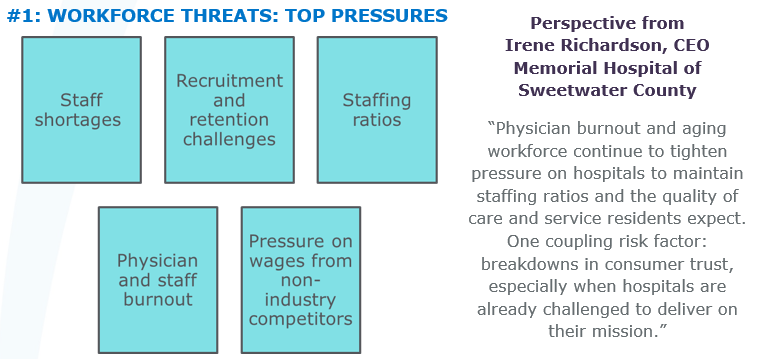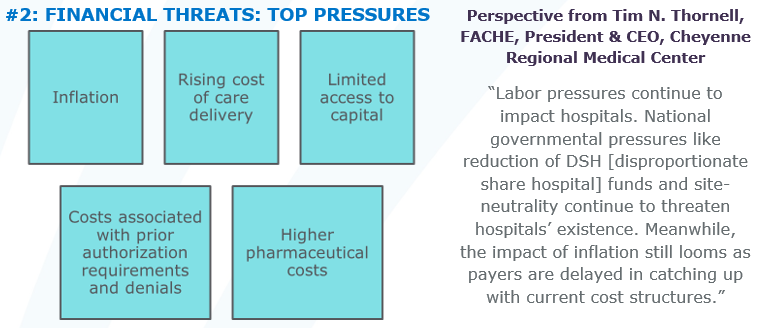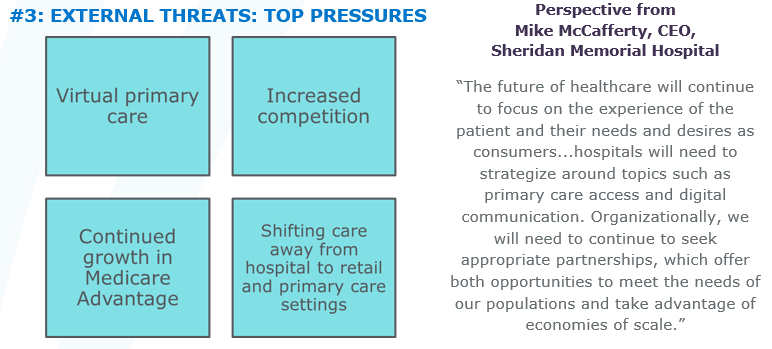3 Threats to Hospitals—and What America’s Frontier State is Doing to Overcome Them
Wyoming may be part of the nation’s frontier healthcare market, but the state is a reminder to hospital leaders everywhere of the challenges all hospitals face, no matter the level of sophistication or setting. It’s unmistakable: we’re all grappling with post-COVID’s three-headed monster of workforce shortages, externalities, and financial pressures.
I was pleased to host a panel discussion at the Wyoming Hospital Association’s annual conference, joined by three proven Wyoming hospital CEOs with battle-tested careers in healthcare. Together, we discussed the three threats with an eye toward a brighter future. The conference also included perspectives from nationally distinguished policymakers, including U.S. Sen. John Barrosso; Wyoming State Hospital Association president Eric Boley; and Rick Pollack, President and CEO of the American Hospital Association (AHA).
Of the three challenges, external threats are most concerning for hospital CEOs. “We can control our costs and manage the workforce, but the external factors like reimbursement cuts, pre-authorization issues, white bagging, private equity and retail healthcare, to name a few, are absolutely out of our control,” Richardson says.
Proposed reductions in DSH payments, which offset uncompensated care in organizations with a high threshold of Medicaid patients, are top of mind for hospital leaders across the country. So is the rise in hospital merger-and-acquisition (M&A) activity, which stalled during the pandemic and is picking up pace.
While the impact of these challenges may vary across organizations, there are steps hospitals can take to strengthen their ability to compete.
Steps To Take
- Work to deepen trust with the communities you serve. One recent survey found nearly half of consumers trust healthcare organizations’ ability to handle major crises less than they did before the pandemic. Patient loyalty—and volumes—depend on an organization’s ability to establish faith in its services and care team within the communities it serves. On the bright side, our nurses, doctors, and pharmacists still rank as the most trusted professions in America. It was put best by someone who recently said of healthcare, “We’re the only field where our outcomes are referred to as miracles, and our workers, saints.”
- Think outside the box for employee recruitment and retention. Wyoming hospitals shoulder high labor expenses, primarily due to the need for travel nurses to cover the load. Yet nursing schools continue to turn away thousands of applicants per year due to lack of capacity. One approach to consider: Look for opportunities to partner with local nursing schools in developing new talent and subsidizing nurse educator positions.
- Consider strategic partnerships with a broad range of players. Rural hospitals may need to collaborate or joint venture with regional health systems or new/emerging ambulatory and specialty care providers.
Looking Forward
Rick Pollack shared some closing thoughts at the WHA fireside chat that best encapsulate how healthcare as an industry ought to be looking forward: “Things right now may feel frustrating and challenging. But I am also encouraged. Our field is on the edge of a revolution. Consider the changes that are taking place in science, information technology, and the management of care. It’s rare when any generation has the ability to impact their field for the future in the way we do today.”
By viewing the challenges of rural hospitals through an “all-hospital lens,” hospital leaders can gain new insight into familiar challenges and alternative solutions that could make a significant impact.
“We’re the only field where our outcomes are referred to as miracles, and our workers, saints.”
Contact the Author:
Jeffery Adler, Managing Director, jadler@veralon.com


